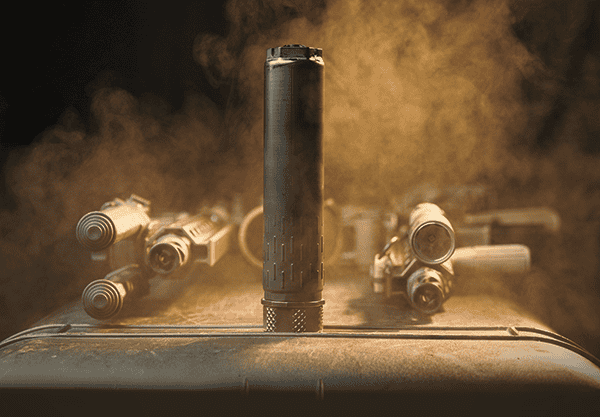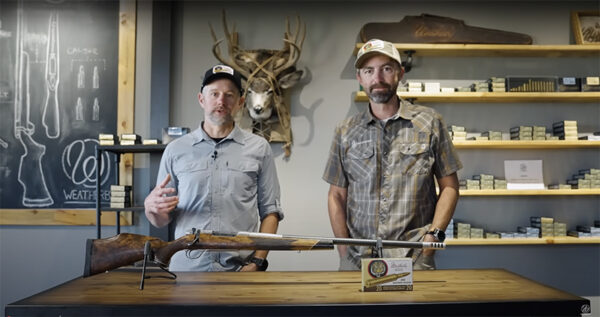“Silence” Is Golden
Booming Market Cracks Sound Barrier For Retailers, Manufacturers
Sound suppressors are a hot growth segment in the firearms industry, and this sounds like a ringing register to savvy marketers.
All the cool kids are using suppressors, including squirrel hunters who use them on .22-cal. rimfire rifles and big-game hunters who want to reduce their sonic footprint and preserve their hearing. Even handgunners use them with increasing frequency.
Suppressors have been available for decades, but demand is soaring because the process for obtaining them is so much easier, contends Josh Hunter, an associate at Fort Thompson Sporting Goods in Sherwood, Ark.
“The demand for suppressors has skyrocketed!” Hunter exclaimed. “Five years ago, I think we sold 14 suppressors over the course of the entire year. Last year we sold over 340. People have always been interested, but it’s easier now as far as the paperwork and applications process are concerned.”
Formerly, a prospective silencer buyer had to be fingerprinted by a law enforcement agency, Hunter said. He had to obtain proper passport-type photographs. He had to snail-mail a check along with a printed application to the Bureau of Alcohol, Tobacco and Firearms.
“And then you had to send everything off and hope it arrived,” he recalled. “The only indicator it had was when your check was processed. These days, as long as you have an eForms account, I can get your fingerprints. I can get your photos. I can build the entire draft here. You look it over. I look it over. We can send it, and you’re done. It’s gone from being a couple days’ process on the low end to maybe 20 or 30 minutes.”
Mach-Plus Territory
Kristopher DiMauro, co-owner of Guerrilla Armament in Jacksonville, N.C., agrees streamlining the application process has pushed the suppressor market into Mach-plus territory.
“We invested a bunch money on a digital fingerprint reader, and that blew up our suppressor sales exponentially,” DiMauro said. “Once the electronic filing kicked into place, it was a little slow burn, but now we’re selling close to 2,000 to 3,000 suppressors a year. The timeline (for approval) around the beginning of eForm went from eight to 12 months to three to six months. It continued for two or three years, but then something happened where wait times just disappeared. Like the flip of a switch, we started getting approval in days. When someone got approved in a couple days, they bought another one.”
As with any business, location is everything. A retailer in a target-rich, avid firearms environment stands to sell more inventory than a retailer in a dabbler environment. Guerrilla Armament is near Camp Lejeune, a giant U.S. Marine Corps base populated by young firearms enthusiasts where turnover is constant.
“The Silencer Shop says we are the number-one dealer in North Carolina,” DiMauro shared. “It’s extremely helpful being near Camp Lejeune. Marines are 18 to 30 years old, and for the most part, Marines have nothing but disposable income, as long as they don’t have a new Ford Mustang at 28% APR.”
With the rise in demand and in profitability, the number of silencer manufacturers has increased. Now, consumers can match a silencer to a specific platform and specific application.
“Now there are a ton of manufacturers making silencers,” DiMauro noted. “Each one is kind of different and unique. With 3D printing, everybody is creating niche designs about how they’re trapping gas, letting it expand and slowing it down.”
The consumer base for suppressors is diverse and dynamic, he added. It truly is a democratic marketplace.
“It used to be only the tactical guys who were into machine guns wanted suppressors,” DiMauro recalled. “It’s everybody now. Yesterday, I sold a .22-caliber suppressor to a 48-year-old woman. I sold a SureFire RC2 to a Marine who turned 21 and wants to finish a clone build of a Mark 18 general issue rifle.”
Popular Applications
West Texas isn’t exactly a dabbler market for suppressors. It’s more like a boutique market, said Danny Anderson, owner of SK Arms in Midland, Texas.
“Our area has a lot of varmint hunters, but this is the ‘Oil Patch’,” he explained. “I have a lot of wealthier clients who take stuff to hunt elk too, but locally they hunt hogs and varmints.”
Because they run multiple platforms, they match an appropriate suppressor to their firearm according to the application.
“A lot of people buy multiple suppressors,” Anderson shared. “Back in the day, because of the paperwork, people wanted to buy one silencer and make it work for as many guns as possible. Now we try to educate people when you do that, you get a jack of all trades and master of none: A silencer not able to work optimally on any of your platforms.”
The most popular applications, Anderson said, are for .22 cal., .30 cal. and 9mm. Diligent Defense is Anderson’s most popular steel silencer. Otter Creek is also popular.
“My market these days is cheaper, simple designs that work on bolt actions, 3D-printed, higher-flow silencers,” he explained. “You’ve got a big gap in the $900–$1,100 price point. Everything is expensive or cheap depending on the application.”
DiMauro says Guerrilla Armament stocks 300 suppressors in 20 different brands. The Dead Air Sierra 5 is his top seller, followed by the Otter Creek Labs Polonium 556. The SilencerCo Sparrow 22 is a popular multi-platform “can.”
“We sell them on everything,” DiMauro said. “Most of the time it’s rifles, but if they want to mount it on a pistol, we sell them a Ruger Mk. 4 or KelTec P17. It’s a fantastic suppressor host.”
Education Key
Despite the soaring popularity of suppressors, Josh Hunter contends customers are not particularly knowledgeable about them. He is constantly educating buyers about the best “can” for their intended application.
“Everyone always comes in looking for a 300 Blackout suppressor,” he informed. “Seventy percent of the time, this is where all these conversations start. It’s a great caliber to suppress and it works really, really well, but it comes with some challenges people aren’t aware of. You can hunt pigs with it. You can hunt deer with it. It’s not going to beat your kids up.”
Hunter declared a sizable portion of his customers have pivoted from 300 Blackout suppressors to those for .45 Colt platforms to great effect.
“I advise your readers to take a good hard look at .45 Colt lever actions. The number of people who come in looking for 300 Blackout platforms and then leave with .45 Colt platforms and come back to tell me just how thrilled they were they went that route is way more than I can count,” he said. “It’s a much easier starter jaunt into suppressors than 300 Blackout because you don’t have to worry about gas systems or any kind of pressures or back pressure or getting gas in your face. It’s quiet, and it’s very, very easy.”
Despite their popularity, Fort Thompson Sporting Goods does not emphasize suppressors, Hunter said, but it’s slowly changing.
“I would say suppressors are probably not all that dissimilar to things like flashlights, lasers — that kind of thing — but the margins on suppressors are pretty decent,” he claimed. “I think it was last year we sat down and had a conversation about suppressors, and the general understanding is we didn’t make any money on them, which is not at all the case. In fact, they are significantly more lucrative to sell than firearms. It was an eye-opener because the impression had always been we really just kept them to bring people in. Until three or four years ago, that was 100% accurate. Within the past four years, sales have gone up and up and up. They are absolutely pulling their own weight as far as an item that’s worth keeping in the store.”
A Backbone
For Guerrilla Arms, suppressors are the backbone of the business.
“Diving into NFA (National Firearms Act) stuff is the best thing we’ve ever done,” DiMauro shared. “I dove so far into it, I changed my signs. Guerrilla Armament, The NFA Experts is on our sign now.”
Several years ago, Guerilla Arms carried SKUs from “six to seven brands,” according to DiMauro. Today, Guerilla Arms carries 300–400 “in stock right now” from 20 different manufacturers, he elaborated.
“Since we pay attention to trends and since we were on the forefront of the suppressor game, we saw it coming. When it did happen, we went headfirst into it,” DiMauro recalled. “When lead times dropped, I invested $50,000 in more suppressors. Luckily, we have great relationships with sales reps and other manufacturers, so we never ran out of cans.”
SK Arms reserves a large section of its facility for storing suppressors, informed Danny Anderson, manager. He, like every other suppressor vendor interviewed for this article, said he was waiting for the passage and enactment of the so-called, “One Big Beautiful Bill Act,” which would remove suppressors from the purview of the National Firearms Act to a less-regulated category under the Hearing Protection Act. The legislation was being debated when this article was written.
“Suppressors will be in incredibly high demand if it happens,” he advised. “Manufacturers will take years to catch up.”
Uncertainty over the bill did cause a slowdown in suppressor sales during the summer, our sources said, because of speculation the heavy tax on suppressors would be eliminated. This would significantly reduce the price of suppressing a firearm, so customers waited.
“People love saving money,” DiMauro concluded. “They’re waiting for legislation that may or may not happen. There will still be a background check and restrictions. I think people look too far into this type of legislation and let it determine what they buy.”





